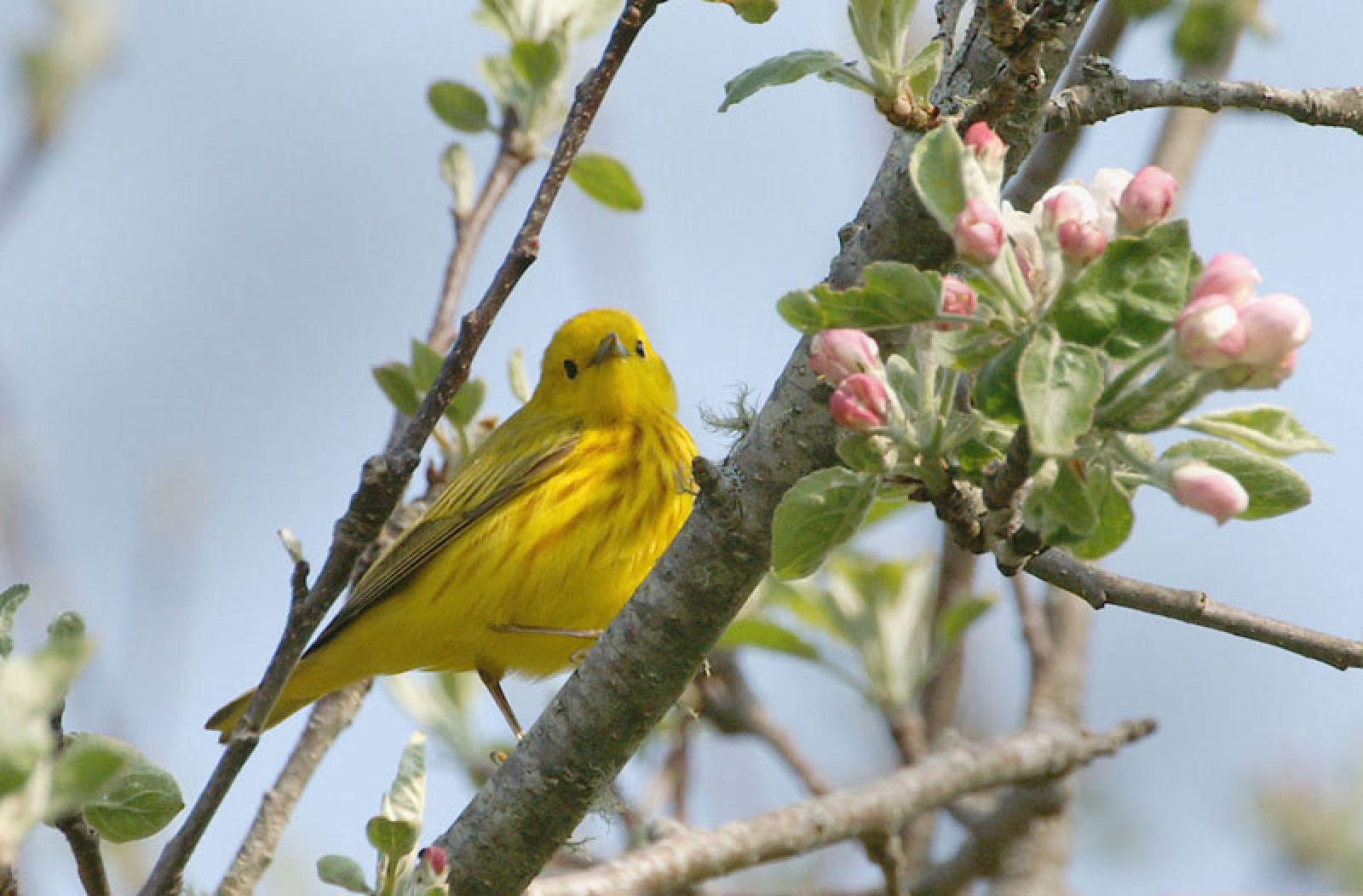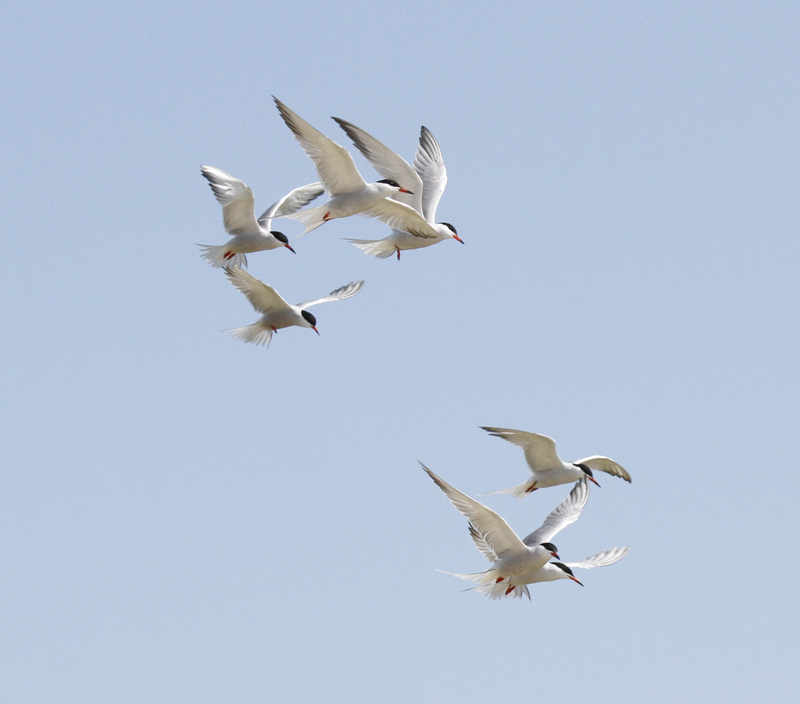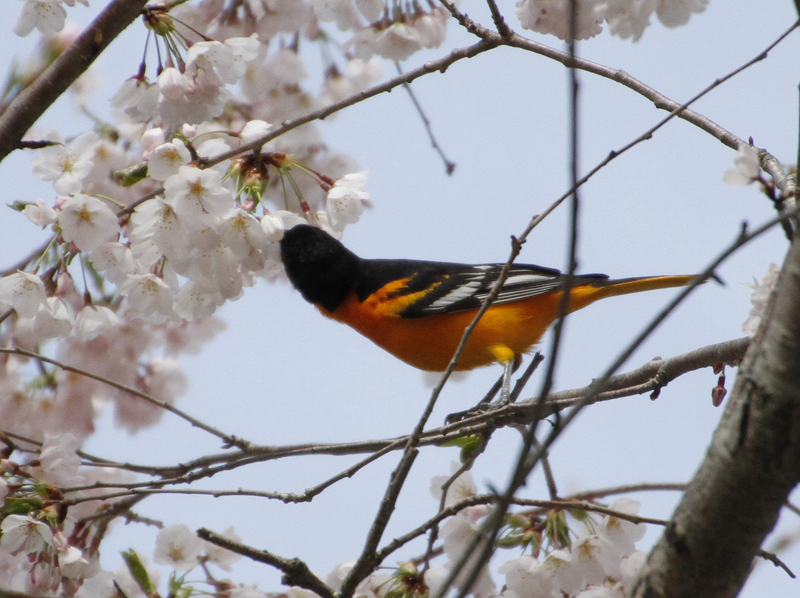What sort of madness prompts a bird to fly thousands of miles every year between the tropics and northern temperate habitats? Millions of birds are moving northward now, most likely because the northern “supermarket” habitats are well stocked with a superabundance of insects to eat. The peak of this migration is here now, as is reflected in the large numbers of species arriving.
Ruby-throated hummingbirds are back in droves. The first ones returned to the Island on April 24 and 25, as reported last week. Many more have returned since then. David Nash observed one on April 26. The next day Janet Norton, Laura Wainwright (at her feeder and in a nearby flowering quince), Debby Lobb Athearn, Beth Mayhew, and Catherine Deese all observed their first hummers. Charlie Kernick, Judith Bryant, Nelson Smith, Tom Hodgson and Marsha Eldridge all reported that their hummers arrived on April 28. A hummer appeared in Luanne Johnson’s yard on April 29, the same day that Allen Slater observed one a few feet away from him at Wasque. On April 30, one showed up at EL Edwards’ home. And on May 1, Nathalie Woodruff reported they finally arrived in her yard. Erica Mason observed one at Mytoi on Chappaquiddick on May 2.
And now that it is time for hummingbird feeders, it is also time for oranges to sprout in yards. They will attract Baltimore orioles, which were first spotted this year by Happy and Steve Spongberg on April 12 — an early date for this species — at Conroy’s when they stopped for coffee. Daisy Kimberly found the next oriole on April 28. And speaking of orioles, Matt Pelikan found an orchard oriole singing near his house in Oak Bluffs on April 29. This oriole is a deep chestnut color where its much more common cousin is bright orange.
The Edgartown Golf Club is apparently a haven for birds. As reported in last week’s column, Ken Magnuson found one of the first ruby-throated hummingbirds of the season. It was trapped in one of the buildings at the golf course. And then, on April 28, he found a yellow-billed cuckoo trapped in the cart barn. The loud calls of this secretive species — never common on the Island — is usually heard while the bird hides motionless in the leafed-out trees. Fortunately, both birds escaped without injury.
Matt Pelikan found three field sparrows singing in the state forest on April 28.
Gus Ben David observed his first male kestrel in several years at Farm Pond on April 29. This species used to be a common breeder here.
Robert and Joyce Mandel reported a rose-breasted grosbeak at their Edgartown feeders on April 29, a day after their first of the year eastern towhees arrived. Catherine Deese also reports a rose-breasted grosbeak at her feeder on May 2.
The first yellow warbler of the season showed up at the Oak Bluffs Pumping Station on April 30, observed by Mr. Magnuson. This species will soon be widespread across the Island as they are possibly our most common warbler, but the pumping station is always a good place to find them. The same day, Mr. Magnuson and Kelley Spenser found the first prairie warbler and blue-headed vireo at Waskosim’s Rock Reservation. Then, just to top off an already good day, they found a blue-gray gnatcatcher in their yard when they got home.
On April 30 Jeff Bernier found some savannah sparrows at the right fork at South Beach in Edgartown. These grassland specialists will live in fields that have almost no shrubs, and in the dunes on our beaches, contrasting to the similar but more widespread song sparrows that live in shrublands and woodland edges.
Karen Dowd and Daisy Kimberly both report eastern towhees in their yards since April 26. On April 29 Daphne DeVries found her first eastern towhee, as did Sioux Eagle. And on May 1, Maggie Bresnahan observed her first catbird of the season in West Tisbury. Both of these species will soon be very common across the island.
Water birds are also on the move. Terns are another new arrival this week. On April 29 Mr. Pelikan observed a few common and roseate terns from the ferry between Woods Hole and Vineyard Haven. Mr. McDowell reported a few terns moving east and north in Vineyard Sound the next day. They were first seen on the Vineyard proper on May 1, when both Rick Dwyer and Luanne Johnson observed their first common terns at Norton Point Beach and Little Beach.
It pays to carefully peruse the fields at the Farm Institute. Mr. Magnuson did so on April 26 and found an adult lesser black-backed gull. The next day he found an American golden plover still in its non-breeding plumage. We do not see this latter species very often in the spring as most of them migrate northward through the Midwestern states.
Jeff Bernier found a willet at Little Beach on April 28.
Mr. McDowell heard bird calls he did not recognize on May 2, which he determined were Bonaparte’s gulls flying northward. He was not able to find the birds because of the low clouds.
From this week’s column you might think that all birds are migrants. Of course, that is not true. As reported last week, a barred owl — or two or three — strayed to the Vineyard two weeks ago. The North Road and Island Grove bird has been heard twice more. Michael and Lynn Ditchfield heard it calling near their Chase Road home at 1:30 a.m. on April 29. And Cynthia Meisner heard it in the late evening at her Sweetened Water Farm home on April 30. All these sightings are remarkably close together, so the owl seems to be staying in approximately a one square mile area.
Peak migration is here, so please get out looking for birds, and be sure to report your sightings to birds@mvgazette.com.
Robert Culbert leads guided birding tours and is an ecological consultant living in Vineyard Haven.







Comments
Comment policy »